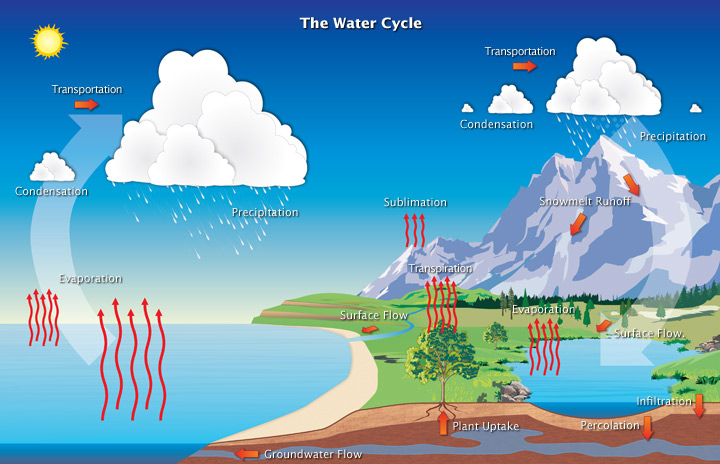Briefly Describe the Movement of Water Through the Water Cycle
The water or hydrologic cycle describes the pilgrimage of water as water molecules make their way from the Earths surface to the atmosphere and back again in some cases to below the surface. The global water cycle can be described with nine major physical processes which form a continuum of water movement.

The Water Cycle In This Simplified Diagram Of The Water Cycle Water Download Scientific Diagram
If youre seeing this message it means were having trouble loading external resources on our website.

. Ice is solid water. Most of Earths freshwater is ice locked in massive glaciers ice sheets and ice caps. The continuous movement of water from the surface to clouds and from clouds to the surface is also called as the Hydrologic cycleThe process of the water cycle mainly includes 4 steps they are - Evaporation Condensation Precipitation Runoff and infiltration.
- when water falls on land a portion of the water soaks into the ground slowly moving downward then laterally finally seeping into lakes streams or directly into the ocean. Its simply transformed transported and recycled. When water evaporates it takes energy from the surrounding environment.
Briefly describe the water cycle and the source of energy that drives it. When water condenses it releases energy and warms the environment. Surface runoff and groundwater movement.
Complex pathways include the passage of water from the gaseous envelope around the planet called the atmosphere through the bodies of water on the surface of earth such as the oceans glaciers and lakes and at the same time or more slowly. View the full answer. The hydrologic cycle describes the continuous movement of water above on and below the surface of the Earth.
In terms of water the earth is a closed system so water isnt added or removed from earth. Water travels through the hydrologic cycle in various forms of movement such as evaporation condensation precipitation runoff infiltration. The ocean lakes rivers and underground aquifers all hold liquid water.
Solid liquid and vapor. The water on the Earths surface--surface water--occurs as streams lakes and wetlands as well as bays and oceans. Then it condenses which it turns from gas to a.
Earths water is always in movement and the natural water cycle also known as the hydrologic cycle describes the continuous movement of water on above and below the surface of the Earth. Environmental scientists know that the hydrologic cycle includes various processes that change water from solid to liquid to gas form and transport it to every corner of earths surface and below. As ice melts it turns to liquid.
When the evaporated water vapour loses its thermal energy it. Hydrologic cycle has no particular ending or a specific beginning. Water is always changing states between liquid vapor and ice with these processes happening in the blink of an eye and over millions of years.
Through the water cycle water continually circulates through three states. Rather water from the ocean evaporates in form of gas into the atmosphere as vapor Clouds. Learn how water moves through Earths ecosystems.
Water Cycle - The process of moving the earths water above and below the surface is called the water cycle. Briefly describe the movement of water through the hydrologic cycle. Next it moves through evaporation or the process by which water is converted from its liquid state.
Transpirationis the loss of water through minute pores in the leaves. Briefly describe how water moves through the hydrologic cycle. This is the initial stage of the water cycle.
Recall there are 5 major processes involved in the hydrologic cycle. The water first evaporates. Evaporation refers to the movement of water from the Earths surface to the atmosphere.
During the water cycle water in the water bodies get heated up and evaporates in the form of vapour mixes with the air and disappears. Terms in this set 5 Identify two ways in which water returns to the oceans from land. The 5 major processes involved are- Evapotranspiration Condensation Precipitation Runoff Infiltration.
In so doing the water goes through different phases. Is the water cycle a movement of water through the environment in different forms. This gigantic system powered by energy from the Sun is a continuous exchange of moisture between the oceans the atmosphere and the land.
The water cycle begins with surface water which is represented by rivers lakes and oceans. Liquid solid and gas. During evaporation the liquid form of water is converted to the gaseous or vapour state.
When the rate of rainfall exceeds the Earths ability to absorb it the surplus. Briefly describe the movement of water through the water cycle. The process by which water from its liquid state changes to vapour a gaseous state is termed as evaporation.
The Hydrologic Cycle also called the Water Cycle is the continuous movement of water in the air on the surface of and below the Earth. Surface water also includes the solid forms of water-- snow and ice. The movement of water.
This cycle is the exchange of energy which influences climate. The moisture in the atmosphere finally returns to the surface of the earth as rains or in form of snow and flows back into the ocean Oliver 2011. Describe three ways in which humans may intervene in the water cycle and the effects of these interventions.
Evaporation transpiration condensation precipitation and runoff are the most important processes in the water cycle. The water moves from one reservoir to another such as from river to ocean or from the ocean to the atmosphere by the physical processes of evaporation condensation precipitation infiltration runoff and subsurface flow.

Water Cycle Diagram Water Cycle Diagram Cycle Drawing Water Cycle

Comments
Post a Comment